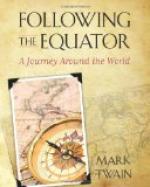Let us now examine history, and see what it teaches. In the 4 battles fought in 1881 and the two fought by Jameson, the British loss in killed, wounded, and prisoners, was substantially 1,300 men; the Boer loss, as far as is ascertainable, eras about 30 men. These figures show that there was a defect somewhere. It was not in the absence of courage. I think it lay in the absence of discretion. The Briton should have done one thing or the other: discarded British methods and fought the Boer with Boer methods, or augmented his own force until—using British methods—it should be large enough to equalize results with the Boer.
To retain the British method requires certain things, determinable by arithmetic. If, for argument’s sake, we allow that the aggregate of 1,716 British soldiers engaged in the 4 early battles was opposed by the same aggregate of Boers, we have this result: the British loss of 700 and the Boer loss of 23 argues that in order to equalize results in future battles you must make the British force thirty times as strong as the Boer force. Mr. Garrett shows that the Boer force immediately opposed to Jameson was 2,000, and that there were 6,000 more on hand by the evening of the second day. Arithmetic shows that in order to make himself the equal of the 8,000 Boers, Jameson should have had 240,000 men, whereas he merely had 530 boys. From a military point of view, backed by the facts of history, I conceive that Jameson’s military judgment was at fault.
Another thing.—Jameson was encumbered by artillery, ammunition, and rifles. The facts of the battle show that he should have had none of those things along. They were heavy, they were in his way, they impeded his march. There was nothing to shoot at but rocks—he knew quite well that there would be nothing to shoot at but rocks—and he knew that artillery and rifles have no effect upon rocks. He was badly overloaded with unessentials. He had 8 Maxims—a Maxim is a kind of Gatling, I believe, and shoots about 500 bullets per minute; he had one 12 1/2-pounder cannon and two 7-pounders; also, 145,000 rounds of ammunition. He worked the Maxims so hard upon the rocks that five of them became disabled—five of the Maxims, not the rocks. It is believed that upwards of 100,000 rounds of ammunition of the various kinds were fired during the 21 hours that the battles lasted. One man killed. He must have been much mutilated. It was a pity to bring those futile Maxims along. Jameson should have furnished himself with a battery of Pudd’nhead Wilson maxims instead, They are much more deadly than those others, and they are easily carried, because they have no weight.




